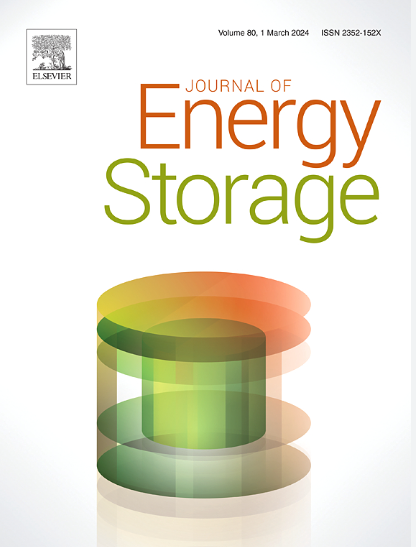Reduced graphene oxide/calcium alginate/polyethylene glycol composite phase change material with double-network structure for enhanced photothermal conversion
IF 8.9
2区 工程技术
Q1 ENERGY & FUELS
引用次数: 0
Abstract
Phase change materials (PCMs) are widely used in thermal energy storage and temperature regulation due to their ability to absorb and release latent heat during phase transitions. However, conventional PCMs often suffer from leakage and low thermal conductivity, which significantly limits their practical applications. Although polymer networks have been employed to encapsulate PCMs, challenges such as lack of functional modification, complex processing steps and high production costs still need to be resolved. We presented a strategy for synthesizing a double-network composite phase change material through the in situ self-assembly of graphene oxide (GO) within a sodium alginate (SA) matrix, combined with ionic crosslinking between SA and Ca2+, resulting in a reduced graphene oxide/calcium alginate/polyethylene glycol (RGO/CA/PEG) composite phase change material. CA imparted good dispersibility to RGO under the premise of effective encapsulation of PEG, and reduced the pressure of RGO encapsulation, resulting in a significant reduction in the preparation cost of the material. The results show that the RGO/CA/PEG has a high energy storage density (145.54 J/g) and can be maintained at 70 °C for 6 h without any leakage. Meanwhile, the construction of the RGO/CA double network enabled the PEG to have good thermal conductivity (127.78 % improvement over pure PEG) and photothermal conversion (85.54 %). The above studies show that the material has good application prospects for solar energy harvesting, battery thermal management, and thermal energy storage.

用于增强光热转化的还原氧化石墨烯/海藻酸钙/聚乙二醇复合相变材料
相变材料因其在相变过程中吸收和释放潜热的能力而被广泛应用于储热和温度调节领域。然而,传统的pcm经常存在泄漏和低导热性,这极大地限制了它们的实际应用。尽管聚合物网络已被用于封装pcm,但诸如缺乏功能修饰、复杂的加工步骤和高生产成本等挑战仍然需要解决。我们提出了一种合成双网络复合相变材料的策略,通过在海藻酸钠(SA)基体中原位自组装氧化石墨烯(GO),结合SA和Ca2+之间的离子交联,得到还原氧化石墨烯/海藻酸钙/聚乙二醇(RGO/CA/PEG)复合相变材料。CA在有效封装PEG的前提下赋予RGO良好的分散性,降低了RGO的封装压力,使得材料的制备成本显著降低。结果表明,RGO/CA/PEG具有较高的储能密度(145.54 J/g),可在70℃下保持6 h无泄漏。同时,RGO/CA双网络的构建使PEG具有良好的导热性(比纯PEG提高127.78%)和光热转化率(提高85.54%)。上述研究表明,该材料在太阳能收集、电池热管理、热能储存等方面具有良好的应用前景。
本文章由计算机程序翻译,如有差异,请以英文原文为准。
求助全文
约1分钟内获得全文
求助全文
来源期刊

Journal of energy storage
Energy-Renewable Energy, Sustainability and the Environment
CiteScore
11.80
自引率
24.50%
发文量
2262
审稿时长
69 days
期刊介绍:
Journal of energy storage focusses on all aspects of energy storage, in particular systems integration, electric grid integration, modelling and analysis, novel energy storage technologies, sizing and management strategies, business models for operation of storage systems and energy storage developments worldwide.
 求助内容:
求助内容: 应助结果提醒方式:
应助结果提醒方式:


